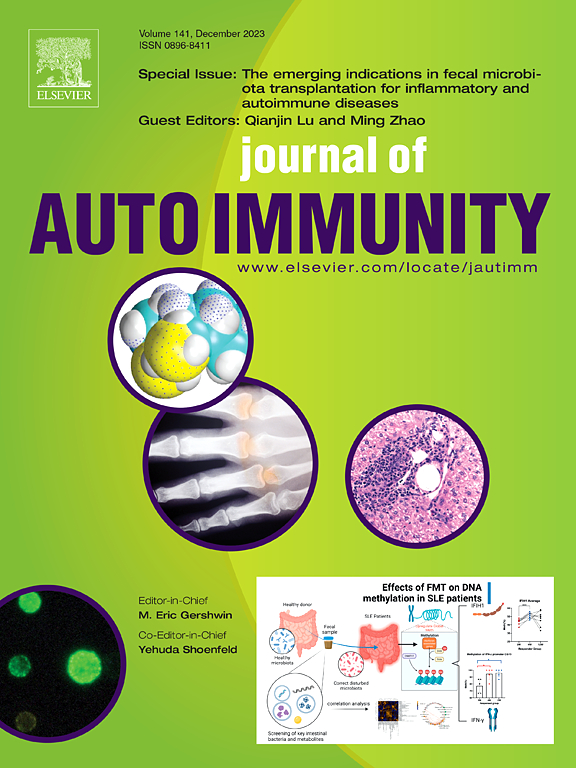Autoreactive B cells remain active despite clinical disease control in rheumatoid arthritis
IF 7.9
1区 医学
Q1 IMMUNOLOGY
引用次数: 0
Abstract
Background
Autoimmune diseases (AIDs) are frequently hallmarked by the presence of autoreactive B cell responses which are involved in disease pathogenesis. However, the dynamics of such responses and their relation to clinical disease activity in humans is poorly understood. Rheumatoid arthritis (RA), a prototypic chronic AID, is hallmarked by B cell responses directed against citrullinated proteins.
Objective
To determine the relation between the activity of the anti-citrullinated protein antibody (ACPA) B cell response and clinical disease activity in ACPA+ patients with RA.
Methods
Expression of B cell activation markers by ACPA+, tetanus toxoid (TT)+ and ACPA− memory B cells (MBCs) from peripheral blood of ACPA+ RA patients receiving different treatments was analyzed by flow cytometry. Results were correlated to clinical disease activity.
Results
Compared to TT+ and ACPA− MBCs, ACPA+ MBCs displayed a highly activated phenotype as evidenced by increased expression of Ki-67, CD86, CD80, CD19 and CD20 and reduced expression of CD32. The activated phenotype of ACPA+ MBCs did not associate with clinical disease activity in a cross-sectional analysis of RA patients treated with various therapeutic agents. Also, in a longitudinal analysis of patients treated with Janus kinase (JAK) inhibitors, ACPA+ MBCs retained their activated phenotype despite effective control of inflammation and clinical disease.
Conclusion
ACPA+ MBCs remain active despite clinical disease control in patients with RA across a range of interventions. This persistent activity indicates the absence of immunological remission and might explain why ACPA+ patients rarely reach sustained drug-free remission and frequently flare upon drug tapering.
尽管类风湿性关节炎患者的临床病情得到控制,但自反应性 B 细胞依然活跃。
背景:自身免疫性疾病(AIDs)通常以自身反应性 B 细胞反应为特征,这种反应参与了疾病的发病机制。然而,人们对这种反应的动态及其与人类临床疾病活动的关系知之甚少。类风湿性关节炎(RA)是一种典型的慢性 AID,其特征是针对瓜氨酸蛋白的 B 细胞反应:目的:确定抗瓜氨酸蛋白抗体(ACPA)B 细胞反应的活性与 ACPA+ RA 患者临床疾病活动性之间的关系:方法:通过流式细胞术分析接受不同治疗的ACPA+ RA患者外周血中ACPA+、破伤风类毒素(TT)+和ACPA-记忆B细胞(MBC)的B细胞活化标志物表达。结果与临床疾病活动性相关:结果:与TT+和ACPA- MBC相比,ACPA+ MBC表现出高度活化的表型,表现为Ki-67、CD86、CD80、CD19和CD20的表达增加,CD32的表达减少。在对接受各种治疗药物的 RA 患者进行的横断面分析中,ACPA+ MBC 的活化表型与临床疾病活动无关。此外,在对接受Janus激酶(JAK)抑制剂治疗的患者进行的纵向分析中,尽管炎症和临床疾病得到了有效控制,但ACPA+ MBC仍保留了其活化表型:结论:尽管RA患者的临床疾病得到了控制,但ACPA+ MBC在一系列干预措施后仍保持活性。这种持续的活性表明缺乏免疫学缓解,这或许可以解释为什么ACPA+患者很少能达到持续的无药缓解,而且在减药后经常复发。
本文章由计算机程序翻译,如有差异,请以英文原文为准。
求助全文
约1分钟内获得全文
求助全文
来源期刊

Journal of autoimmunity
医学-免疫学
CiteScore
27.90
自引率
1.60%
发文量
117
审稿时长
17 days
期刊介绍:
The Journal of Autoimmunity serves as the primary publication for research on various facets of autoimmunity. These include topics such as the mechanism of self-recognition, regulation of autoimmune responses, experimental autoimmune diseases, diagnostic tests for autoantibodies, as well as the epidemiology, pathophysiology, and treatment of autoimmune diseases. While the journal covers a wide range of subjects, it emphasizes papers exploring the genetic, molecular biology, and cellular aspects of the field.
The Journal of Translational Autoimmunity, on the other hand, is a subsidiary journal of the Journal of Autoimmunity. It focuses specifically on translating scientific discoveries in autoimmunity into clinical applications and practical solutions. By highlighting research that bridges the gap between basic science and clinical practice, the Journal of Translational Autoimmunity aims to advance the understanding and treatment of autoimmune diseases.
 求助内容:
求助内容: 应助结果提醒方式:
应助结果提醒方式:


